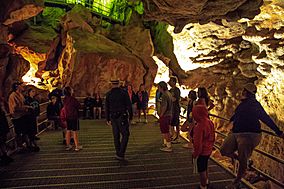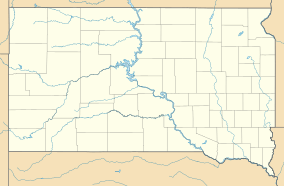Jewel Cave National Monument facts for kids
Quick facts for kids Jewel Cave National Monument |
|
|---|---|
|
IUCN Category III (Natural Monument)
|
|

Visitors and guide inside Jewel Cave
|
|
| Location | Custer County, South Dakota, U.S. |
| Nearest city | Custer, South Dakota |
| Area | 1,273 acres (5.15 km2) |
| Created | February 7, 1908 |
| Visitors | 137,275 (in 2016) |
| Governing body | National Park Service |
| Website | Jewel Cave National Monument |
Jewel Cave National Monument is home to Jewel Cave. This amazing place is currently the third longest cave in the world! It has over 200.3 miles (322.4 kilometers) of mapped tunnels and rooms. You can find it about 13 miles (21 km) west of Custer, in the Black Hills of South Dakota. Jewel Cave became a national monument in 1908.
Contents
Discovering Jewel Cave's Secrets
How Jewel Cave Was Found
In 1900, two local gold hunters, Frank and Albert Michaud, found the cave. They felt cold air blowing from a small hole in a canyon. No one knows if people living there before them knew about this natural opening. It was too small for a person to enter.
The Michaud brothers used dynamite to make the entrance bigger. Inside, they found a huge room filled with shiny calcite crystals. Because of these sparkling crystals, they named it "Jewel Cave."
Early Days of the Monument
The brothers tried to make money from their discovery. They made the opening wider, built walkways, and let tourists visit. Their business didn't last, but news of the cave reached Washington, D.C. On February 7, 1908, President Theodore Roosevelt officially made Jewel Cave a National Monument.
In the 1930s, the Civilian Conservation Corps helped develop the area around the cave's natural entrance. The National Park Service took over managing the monument in 1933. They started offering tours to visitors in 1939.
Exploring the Hidden Passages
By 1959, only about 2 miles (3.2 km) of the cave had been explored. But that year, Herb and Jan Conn, who were local rock climbers, started exploring. In just two years, they mapped 15 miles (24 km) more!
Much of their new discoveries were outside the monument's original boundaries. So, in 1965, the Park Service and the United States Forest Service traded land. This allowed the park to include more of the cave. The Park Service then built a 300 feet (91 m) elevator shaft down into a new part of the cave. They also added concrete paths and metal stairs. This new "Scenic Tour" opened in 1972. Today, most visitors take this tour.
In August 2000, a large forest fire burned about 90% of the monument and the land around it. Luckily, the visitor center and historic buildings were saved.
Deep Dive into Exploration
Continuing the Journey
By 1979, Herb and Jan Conn had discovered and mapped over 64 miles (103 km) of passages. Even though they mostly stopped caving in the early 1980s, exploration has continued. Some areas are so far away that explorers now camp inside the cave for up to four days!
Cave explorers map the cave using special tools. They use a compass and a clinometer (to measure angles). Today, they use lasers instead of tape measures to get very accurate measurements.
How Big is Jewel Cave?
With 198.00 mi (318.65 km) of mapped passages, Jewel Cave is the third longest cave in the world. It's only shorter than Mammoth Cave in Kentucky and Sistema Sac Actun in Mexico.
Scientists believe that the explored parts of Jewel Cave are only about 3 to 5% of its total size! They figure out the cave's total size by measuring how much air it "breathes." The cave "exhales" air when the outside air pressure drops and "inhales" when it rises.
The Science of Jewel Cave
A Breathing Cave
Jewel Cave is known as a "breathing cave." This means air moves in and out of the cave as the air pressure outside changes. This happens from day to night or when the weather changes. Herb Conn first explained this amazing natural process in 1966.
How the Cave Formed
Most of Jewel Cave formed within the Pahasapa Limestone. This rock was laid down about 350 million years ago during the Mississippian period. Later, other rocks like limestones, sandstones, and shales were deposited.
Then, the Black Hills began to rise up about 58 to 54 million years ago. This process, called geologic uplift, caused the softer rocks to wear away. The main passages of Jewel Cave then formed. As the land continued to rise, the water table dropped, and the cave became dry.
Amazing Cave Formations
The passages of Jewel Cave follow natural cracks in the rock called joints. These cracks are linked to the uplift of the Black Hills. After the main cave dissolved, a thick layer of calcite coated the walls about 2.5 million years ago.
Over time, many beautiful cave formations, called speleothems, grew. These include the sparkling "jewels" or spar crystals that gave the cave its name. Other formations you can see are:
- Stalactites (hanging from the ceiling)
- Stalagmites (growing from the floor)
- Flowstone (sheets of rock formed by flowing water)
- Cave popcorn (small, bumpy growths)
- Boxwork (thin, blade-like formations)
- Helictites (twisted, gravity-defying growths)
- Cave pearls (smooth, round stones)
- Frostwork (delicate, needle-like crystals)
You can also find gypsum formations like needles, beards, and flowers. Jewel Cave even has a very rare formation called a hydromagnesite balloon. These are like hollow, balloon-shaped structures made from a special mineral. They form when gas inflates a soft, pasty substance.
Visiting Jewel Cave
Jewel Cave is open all year round for visitors. The National Park Service offers different ways to explore:
- The Scenic Tour: This is a half-mile loop through a paved and lit part of the cave. You take an elevator down to reach it.
- The Historic Tour: This is a candlelight tour through the first parts of the cave ever discovered.
- The Wild Caving Tour: For the more adventurous, this tour goes through an undeveloped part of the cave.
There are also three walking trails on the surface, with different lengths and difficulty levels.
Images for kids









